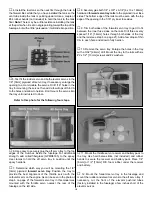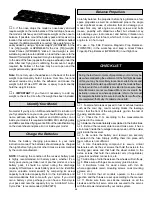
❏
3. If the nose drops the model is nose-heavy and will
require weight on the tail to balance. If the tail drops, however,
the model is tail heavy and will require weight on the nose to
balance. If possible, mount the battery pack and receiver in a
location that will minimize or eliminate any additional ballast
required. If additional weight is required, nose weight may be
easily added by using a “spinner weight” (GPMQ4645 for the
1 oz. [29g] weight, or GPMQ4646 for the 2 oz. [57g] weight).
Great Planes (GPMQ4485) “stick-on” lead weight is also
suitable. A good place to add stick-on lead to the nose is to the
firewall. If tail weight is required it may be temporarily attached
to the side of the fuse (opposite the engine exhaust) under the
stab. After test flying and confirming the amount of weight
required, the bottom of the fuse may be cut open and the
weight permanently glued inside.
Note: Do not rely upon the adhesive on the back of the lead
weight to permanently hold it in place. Over time, fuel and
exhaust residue may soften the adhesive and cause the
weight to fall off. Use RTV silicone or epoxy to permanently
hold the weight in place.
❏
4. IMPORTANT: If you found it necessary to add any
weight, recheck the C.G. after the weight has been installed.
No matter if you fly at an AMA sanctioned R/C club site or if
you fly somewhere on your own, you should always have your
name, address, telephone number and AMA number on or
inside your model. It is required at all AMA R/C club flying sites
and AMA sanctioned flying events. Fill out the identification tag
on the decal sheet and place it on or inside your model.
Follow the battery charging procedures in your radio
instruction manual. The batteries should always be charged
the night before flying and at other times as recommended
by the radio manufacturer.
NOTE: Checking the condition of the receiver battery pack
is highly recommended. All battery packs, whether it's a
trusty pack you've just taken out of another model, or a new
battery pack, it should be cycled noting the discharge
capacity. Oftentimes a weak battery pack can be identified
(and a valuable model saved!) by comparing its actual
capacity to its rated capacity. Refer to the instructions and
recommendations that come with your cycler. If you don't
own a battery cycler, perhaps you can have a friend cycle
your pack and note the capacity for you. A Hobbico
®
Accu-
Cycle Plus
™
is recommended (HCAP0270).
Carefully balance the propeller before flying. Balance a few
spare propellers as well. An unbalanced prop is the single
most significant cause of vibration that can damage your
model. Not only will engine mounting screws and bolts
loosen, possibly with disastrous effect, but vibration may
also damage your radio receiver and battery. Vibration can
also cause your fuel to foam, which will, in turn, cause your
engine to run hot or quit.
We use a Top Flite Precision Magnetic Prop Balancer
™
(TOPQ5700) in the workshop and keep a Great Planes
Fingertip Prop Balancer (GPMQ5000) in our flight box.
❏
1. Fuelproof all areas exposed to fuel or exhaust residue
such as the cowl ring, cowl mounting blocks, the fuselage
former that the front of the wing dowels go into, the rest of
the wing saddle area, etc.
❏
2. Check the C.G. according to the measurements
provided in the manual.
❏
3. Balance the model laterally as explained in the instructions.
❏
4. Extend the receiver antenna and make sure it has a
strain relief inside the fuselage to keep tension off the solder
joint inside the receiver.
❏
5. Be certain the battery and receiver are securely
mounted in the fuse. Simply stuffing them into place with
foam rubber is not sufficient.
❏
6. Use threadlocking compound to secure critical
fasteners such as the set screws that hold the axles to the
landing gear wires and that hold the wheel collars to the
axles, screws that hold the carburetor arm (if applicable),
screw-lock pushrod connectors, etc.
❏
7. Add a drop of oil to the axles so the wheels will turn freely.
❏
8. Make sure all hinges are securely glued in place.
❏
9. Reinforce holes for wood screws with thin CA
where appropriate (servo mounting screws, cowl mounting
screws, etc.).
❏
10. Confirm that all controls operate in the correct
direction and the throws are set up according to the manual.
❏
11. Make sure there are silicone retainers on all the
clevises and that all servo arms are secured to the servos
with the screws included with your radio system.
During the last few moments of preparation your mind may be
elsewhere anticipating the excitement of the first flight. Because
of this, you may be more likely to overlook certain checks and
procedures that should be performed before the model is flown.
To help avoid this, a checklist is provided to make sure these
important areas are not overlooked. Many are covered in the
instruction manual, so where appropriate, refer to the manual
for complete instructions. Be sure to check the items off as they
are completed (that's why it's called a
check list!).
CHECK LIST
Balance Propellers
Charge the Batteries
Identify Your Model
29




































